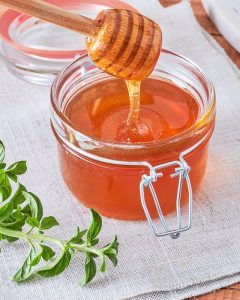 If you’ve never been to one of the bee ranches near San Antonio, Texas, it can be an education. What is honey? How bees make it is amazing. Forager bees collect the nectar of flower, then consume that nectar, storing it in their crop—honey stomach—taking it back to the hive. It’s not digested, but regurgitated into the crop of a processor bee at the entrance of the hive. Processor bees have an enzyme, invertase, that is mixed with the honey when they regurgitate it into the comb cells. That breaks the sucrose and water from the nectar down to glucose and fructose. Then the bees remove the water from the nectar by flapping their wings and increasing air flow.
If you’ve never been to one of the bee ranches near San Antonio, Texas, it can be an education. What is honey? How bees make it is amazing. Forager bees collect the nectar of flower, then consume that nectar, storing it in their crop—honey stomach—taking it back to the hive. It’s not digested, but regurgitated into the crop of a processor bee at the entrance of the hive. Processor bees have an enzyme, invertase, that is mixed with the honey when they regurgitate it into the comb cells. That breaks the sucrose and water from the nectar down to glucose and fructose. Then the bees remove the water from the nectar by flapping their wings and increasing air flow.
Honey has its downside.
The nectar collected is sucrose. That’s table sugar. It’s converted to glucose and fructose. Both of these are simple sugars. Sugar, no matter what form, has calories and isn’t healthy used in higher quantities. Babies under a year shouldn’t be given honey. The ripening process removes the water to a point no microbes can grow. Once it’s dry, it’s capped with a wax seal. While there are no live microbes, there still can be spores, like botulinum spores. Once consumed they can become viable. For adults, it’s not a problem, but babies have undeveloped immune systems that can’t fight them off, so it can be dangerous to give to infants.
Clear honey looks more inviting, but is it better for you?
When you process honey, it makes it clearer. The more processed it is, the clearer it is. Raw honey is hazier because it contains more beneficial enzymes and pollen. It has minerals, antioxidants and many health benefits. Many doctors and medical groups endorse giving natural honey with lemon as a treatment for coughs. It has anti-inflammatory properties to reduce inflammation that can cause heart disease, Alzheimer’s, cancer and autoimmune disorders.
The type of nectar used to make the honey determines the health benefits.
Acacia honey is honey that comes from the black locust trees, also known as false acacia. It can help treat resistant bacteria and certain types of cancer. Buckwheat honey may be the top choice for coughs and scratchy throats because it’s high in antioxidants. It’s also known for wound healing and lowering cholesterol. Manuka honey, originally only found in New Zealand, comes from the honey of the manuka bush. It is exceptional in treating diabetic ulcers and burns. It keeps the area moist, while reducing inflammation. It’s also antibacterial and maintains the proper pH for healing. All are important to help proper healing.
- Honey has different colors and flavors based on the pollen used. Wildflower honey is pale and is excellent for cough suppression and fighting seasonal allergies.
- Basswood honey has a light delicate taste. It can help with bronchitis and colds. People who have digestive issues often turn to sage honey and to boost immunity for chronic illness, blueberry honey is the solution.
- One of the mildest types of honey, which may taste like the sweetest, with an almost buttery taste, is tupelo honey. It has antibacterial and antioxidant benefits.
- Orange blossom honey provides immune support. While never proven, many believe that local raw honey can help with allergies.
For more information, contact us today at Iron Fit San Antonio
